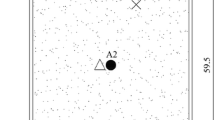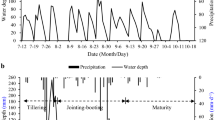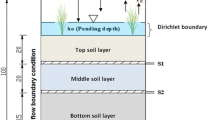Abstract
Based on an experimental field study in Japan, a model was developed to simulate dissolved nitrogen in water ponded in a paddy field. As input data, the model uses meteorological data, water balance in the field, nitrogen concentration in inlet water, and the nitrogen contribution of applied fertilizer. Five model parameters need calibration. A practical application of the model is the simulation of NH4-N and NO2+3-N concentrations in water ponded in a paddy field. The model improves our understanding of the interactions between forms of dissolved nitrogen in ponded water and can explain the complex changes in dissolved nitrogen concentrations in water ponded on a paddy field.








Similar content being viewed by others
References
Bergstrom L, Johnsson H, Torstensson G (1991) Simulation of soil-nitrogen dynamics using the SOILN model. Fert Res 27(2–3):181–188
Bradbury NJ, Whitmore AP, Hart PBS, Jenkinson DS (1993) Modeling the fate of nitrogen in crop and soil in the years following application of N-15-labeled fertilizer to winter wheat. J Agric Sci 121(3):363–379
Chen CW, Orlob GT (1975) Ecologic simulation for aquatic environments. In: Systems analysis and simulation in ecology, vol. III. Academic Press, New York, pp 476–588
Eppley RW (1972) Temperature and phytoplankton growth in the sea. Fish Bull 70: 1063–1085
FAO (1998) Crop evapotranspiration: guidelines for computing crop water requirements. Irrig Drain Pap 56
Greenwood DJ, Rahn C, Draycott A, Vaidyanathan LV, Paterson C (1996) Modelling and measurement of the effects of fertilizer-N and crop residue incorporation on N-dynamics in vegetable cropping. Soil Use Manage 12(1):13–24
Hasebe A, Sekiya S, Iimura K (1985) Direct determination of the differentiation process of the oxidized and reduced soil layers in paddy fields. Jpn Agric Res Q 19:172–177
Ito M, Masujima H (1984) Suitou Saibai oyobi Rati Jyoukenka ni okeru Denmensuityu no Mukitai Tisso to Rin no Noudoteika. The decreasing of inorganic nitrogen and phosphorus concentration in the ponded water on paddy field and uncultivated field (in Japanese). J Soil Sci Manure Jpn 55(2):123–128
Jeon J, Chun G, Ham J, Hwang H (2003) Mass balances analysis and water quality model development for loading estimates from paddy field. 7th Int Conference Diffuse Pollution and Basin Management 3:114–118
JSIDRE [Japanese Society of Irrigation, Drainage and Reclamation Engineering] (2001) Handbook of irrigation, drainage and reclamation engineering, 5th edn (in Japanese). JSIDRE, Japan, pp 113–116
Konno T (1980) Temperature effect on the biological activity of soil (in Japanese with English summary). Soil Phys Cond Plant Growth Jpn 40:7–16
Kubota H, Tabuchi T, Takamura Y, Suzuki S (1979) Water and material (N, P) balance in the paddy fields along Lake Kasumigaura. Trans Jpn Soc Irrig Drain Reclam Eng 84:22–28
Kunimatsu T (1983) Cultivated land: nutrient recycle and water purification of paddy fields (in Japanese). Annual Report of Lake Biwa Research Institute 2:28–35
Kuroda H, Tabuchi T, Kohsaka K, Nakasone H (1995) A study on the sustainability of nitrogen removal in the paddy field (in Japanese with English summary). J Jpn Soc Irrig Drain Reclam Eng 68(9):59–65
MAFF [Ministry of Agriculture Forestry and Fisheries] (2001) Statistics on agriculture forestry and fisheries. (http://www.maff.go.jp/toukei/abstract/1_1/9a.htm)
Miyoshi H (1978) Water pollution and cultivated lands (in Japanese). J Agric Sci 33:390–395
Miyoshi H (ed) (1983) The dictionary of soil and manure words (in Japanese). Rural Culture Association, Japan, pp 96–99
Mori Y (1990) A model for changes in the surface water nitrogen concentration in paddy fields (in Japanese with English abstract). Trans Jpn Soc Irrig Drain Reclam Eng 146:15–25
Nagai A (1993) Estimation of pan-evaporation by the Makkink equation (in Japanese with English abstract). J Jpn Soc Hydrol Water Resour 6(3):238–243
Pang XP, Letey J (1998) Development and evaluation of ENVIRO-GRO, an integrated water, salinity, and nitrogen model. Soil Sci Soc Am J 62(5):1418–1427
Shiratani E, Tohara Y, Shikasho S, Inoue H (1997) Modeling of nitrogen discharge from a barley field. Rural Environ Eng 33:37–53
Shiratani E, Yoshinaga I, Feng Y, Hasebe H (2004) Scenario analysis for reduction of effluent load from an agricultural area by recycling the run-off water. Water Sci Technol 49(3):55–62
Stanford G, Dzienia S, Vander Pol RA (1975) Effect of temperature on denitrification rate in soils. Soil Sci Soc Am Proc 39:867–870
Streeter HW, Phelps EB (1925) A study of pollution and natural purification of the Ohio River, III, Factors concerned in the phenomenon of oxidation and reaeration. Public Health Bulletin no. 146, U.S. Public Health Service, Washington, D.C.
Tabuchi T (1987) The experiment on nitrate removal under flooded paddy field (in Japanese). J Jpn Soc Irrig Drain Reclam Eng 55(8):53–58
Tabuchi T (1993) Experiment on nitrogen removal in flooded paddy field. J Jpn Soc Irrig Drain Reclam Eng 61(12):19–24
Tabuchi T (2001) Nitrate removal in the ponded paddy field. In: Proc Int Workshop on Efficiency of Purification Process in Riparian Buffer Zones, Japan: pp 81–90
Takeda I, Kunimatsu T, Kobayashi S, Maruyama R (1991) Pollutants balance of a paddy field area and its loadings in the water system (in Japanese with English abstract). Trans Jpn Soc Irrig Drain Reclam Eng 153:63–72
Udo A, Jiku F, Okubo T, Nakamura M (2000) Mass balances of water and nutrients in a paddy field (in Japanese with English abstract). Jpn Soc Water Environ 23(5):298–304
Wada E, Uehara Y (1977) Nitrification process in nature (in Japanese). Kagaku to Seibutsu 15(2):98–110
Yoshinaga I, Feng YW, Hasebe H, Shiratani E (2003) Nitrogen removal function of a paddy field in a circular irrigation system. Proc 7th Int Conference Diffuse Pollution and Basin Management 4:43–48
Acknowledgments
We thank the chairman, Mr. Ogushi, and the staff of the Minami-Tsukuba Land Improvement Association for help in carrying out the field investigation. Meteorological data were obtained from the Weather Data Acquisition System of the National Institute of Agro-Environmental Sciences.
Author information
Authors and Affiliations
Corresponding author
Rights and permissions
About this article
Cite this article
Yoshinaga, I., Feng, Y., Singh, R.K. et al. Dissolved nitrogen model for paddy field ponded water during irrigation period. Paddy Water Environ 2, 145–152 (2004). https://doi.org/10.1007/s10333-004-0053-4
Received:
Accepted:
Published:
Issue Date:
DOI: https://doi.org/10.1007/s10333-004-0053-4




